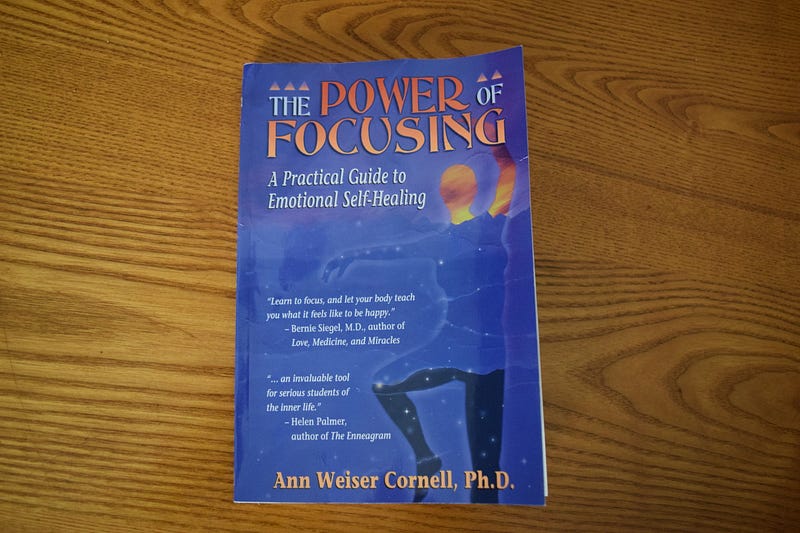Focusing: A Strange, but Effective Alternative to Mindfulness Meditation

Mindfulness is overrated. Focusing is better.
Kidding (sort of).
Vipassana (mindfulness) mediation involves placing your attention on a single event, usually your breath, for a fixed period of time.
You watch your thoughts and feelings stream along while you keep your eye on the breath. If your mind gets distracted from your breath, you gently guide it back and resume your focus.
There is a wealth of scientific evidence that mindfulness can help you reduce anxiety and cultivate wellbeing. I’m not skeptical that it can help people, but there’s a problem here.
Mindfulness is probably the most popular cultural export in the western world next to yoga, and it seems to have taken on the status of a panacea. Mindfulness is the cure for any mental ailment, dissatisfaction, or emotional hang up. You haven’t heard?
The mass saturation of mindfulness is becoming obnoxious, and it’s important to acknowledge that mindfulness doesn’t work for everyone. I learned the value of being present with discomfort through practicing mindfulness, but other than that, mindfulness never really got to the heart of my issues.
It wasn’t until I went to therapy that I discovered something different. It’s called Focusing.
If mindfulness isn’t getting you where you want to be, you might want to try Focusing instead. Think of it as a process of interacting with your feelings, instead of just staring at them.
Focusing at a Glance

I know, it looks like the book comes with a pouch full of crystals. But really, Focusing isn’t any less mystical than “Zen” or “mindfulness meditation.” It’s just not as well known.
I compare Focusing with mindfulness because both involve sitting quietly with the intention of self-observation. Both require learning and practice. And both have a slightly spiritual, hippy appeal.
But trust me, this is a secular, practical skill you can learn to improve your mental health. Focusing is a well-established form of somatic (body-focused) psychotherapy, and the creator of Focusing, Eugene Gendlin, is a noted influence of Bessel Van Der Kolk, author of the groundbreaking work on healing trauma, The Body Keeps Score.
Let me lay out the process and the intention, as told by Dr. Ann Weiser Cornell in The Power of Focusing.
The Philosophy of Focusing
Focusing is the act of being aware of and making conversation with your feelings. It’s listening to your body when it has something to “say,” and letting your feelings do most of the talking. This can lead to personal revelations and cathartic moments of release.
It is based around the awareness of what Gendlin called “felt sense.” Felt senses are sensations you feel in your body in specific situations. An example of a felt sense might be a tightness you feel in your chest before speaking to someone, or a burning sensation in your gut when you think about the future. These are meaningful indicators that your emotions are trying to tell you something.
Normally, we would ignore these feelings or reprimand ourselves for having them. You might chastise yourself for “clamming up” or “choking” when you encounter a felt sense. But with Focusing, you get to acknowledge your felt senses and see what they’re about. This is especially useful if you have a recurring pattern in your feelings that you can’t get beyond.
Focusing was conceived through Eugene Gendlin’s studies on what makes therapy successful for some people and not others. After listening to hours of therapy session recordings, Gendlin discovered that the clients who benefited most from therapy were the ones most in touch with their feelings. The more analytical and “in their head” a client was, the less likely they would benefit from therapy in the long run.
Gendlin created Focusing to guide his more cerebral clients toward what they feel in therapy, as opposed to what they think they should feel. That’s where the breakthroughs occurred.
Summarizing the Process
A Focusing session begins similar to a meditation session. You sit comfortably in a quiet spot with minimal distractions. Then, you set a time limit of 10 to 30 minutes (but it can last as long as it needs to). You’re allowed to sit how you want, and you can even lie down (another perk mindfulness doesn’t have). Here is the process, step by step:
- What Are We Working on Today?
You settle into your body and see if there’s any feeling that sticks out to you. Dr. Cornell would say this feeling is a felt sense that “wants your attention.” Or you can decide to focus on something specific, like a frequent problem you have, a bad habit, your inner critic, or just something that’s bugging you. - Sense Into Your Body
This step is feeling and observing the physical sensations in your body. You direct your attention toward the weight of your clothing and the space you take up in the room. You observe how you feel in your throat, your chest, and your abdomen. You make note of your sensations, whether they’re tightness, heaviness, nervousness, or nothing at all. - What Wants My Awareness?
This is where you begin to listen. You ask yourself “what wants my awareness,” and through that, you are prompting your feelings to bring up what’s most important. In Dr. Cornell’s words, “It’s like saying to a friend, ‘I’m here. What would you like to talk about today?’” - Say Hello to Your Feeling, Describe It, and Check Back with Your Body
You greet the feeling you have. You say “hi tightness,” or “ hi boredom,” or “hi sadness.” That small amount of compassionate openness sets the stage for the work to begin. You start by describing the feeling you’re having as best you can. You can say things like, “dark boredom” or “anxious numbness.” Once you come upon the most accurate description, you will usually experience a feeling of “rightness.” That’s how you know your body resonates with the truth of your statement. At this moment, you’ve started understanding yourself. - Curiosity
At this stage, you settle in with your feeling, and you take on an attitude of curious interest. Even if the feeling is painful or slightly overwhelming, addressing it from a position of curious interest allows you to not be completely absorbed by it. - Going Deeper
This is the stage you begin asking your felt sense questions. The intention is to learn, understand, and discover yourself in a compassionate way. Your feelings aren’t going to answer you as a person would. You’re only looking for a deeper sense of felt understanding, and new insights emerge from there. There are several avenues for this:
- How does it feel from its point of view?
If your felt sense is uncomfortable to you, try imagining how it feels from its perspective. You might say it feels “scared” or “hesitant.” You can discover hidden motivations and the reasons behind your feelings by taking their perspective. - Ask what makes it feel the way it does.
This is my favorite question to ask. You can get far by inquiring about the origins of your feelings. You ask, “what gets you so (emotion)?” You don’t ask why it feels that way because that suggests judgment. You ask what makes it feel that way, and see if you can sense a response. - Ask what it needs.
See what your feeling is looking for by asking what it needs from you, or from life. You don’t want to rush it. It could need compassion, attention, or maybe some encouragement.
Debrief
When it feels like you’ve had enough, you check in with your felt sense and see if it’s ok to stop. You calmly tell your felt sense that you’ll be back if you feel more work needs to be done. Then, you thank your body for being with you and for the responses it was willing to give you.
The Benefits of Focusing
Focusing is tough, but that’s how you know it’s legitimate.
It takes deliberate practice, patience, and concentration before you can consistently reap the benefits. But what’s possible through Focusing is that you can develop a quality relationship with yourself.
You can come to a place where you’re no longer ignorant of your fears, biases, and hang ups. And when you start listening to those feelings, instead of arguing with them logically, you can find release from them, and then positive change can occur. Gendlin called this a “felt shift.”
I wouldn’t call myself a Focusing master, but I’ve used Focusing mostly to deal with a harsh self-critic. Here’s what one meaningful session looked like:
I sat on my bed and placed my awareness in my body. I described what was vying for my attention as a “thorn of shame.” I stayed curious and began asking it questions. A thousand new issues came up, and it was hard to keep up with all the feelings. Sometimes Focusing can be like opening pandora’s box.
During this chaotic session I, no joke, whipped my Focusing book into a wall. But by the end, I managed to extract a nugget of wisdom.
Here’s what I wrote in my journal: “My critical voice is trying to tell me that it doesn’t want me to run from the things I know I can do. My critical voice believes in my ability, and it is protecting me from straying off the path of being the person I want to be.”
That’s one of the main things I learned from Focusing and therapy; That self-criticism is often rooted in fear, and that fear is rooted in some unmet need or self-preservation. In a way, your critic is protecting you from bad outcomes. If you can come to understand it like this, you can almost see it as an ally, and then it isn’t so harsh anymore.
Through Focusing, you’re learning the dynamics of what makes you tick, and that can take you to some significant new places.
Focus
There are many ways of addressing pain and no single method is going to work for everyone. But I would say Focusing is best suited for the type of person who is analytical, self-critical, and out of touch with themselves. I would also say it’s for anyone who feels stuck in their therapy.
If mindfulness works for you, then by all means keep doing it, but know that there are other methods of self-healing, and much more you can potentially discover. You just have to be willing to get a little hippy-dippy, treat yourself with some softness, and have an open ear.



